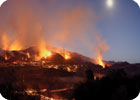Publication
Article: Burning Need to Protect Enterprises from Wildfires
By: Bill Zalud; Industry News – Security Magazine
December 1, 2007


Wildfires in Southern California threatened numerous corporate headquarters and the homes of their employees. A key security effort: a pre-tested disaster plan and diverse means of communicating with employees and government officials.
A handful of big-name corporations evacuated their facilities while others concentrated on informing employees about the status of the recent California wildfires that struck Southern California. The bottom line: Security operations with a disaster plan and strong, diverse communications did a better job of handling the wildfires than those without.
Qualcomm, for example, was affected, not so much that its headquarters was in imminent danger but because many of its 11,000 people in San Diego live in areas hit or threatened by the fires. Sony Electronics closed its Rancho Bernardo U.S. headquarters for days. Other security departments impacted work for Acer/Gateway, EMC, Intel and Microsoft…
Crisis Management
Crisis management plans were also put to the test.
During the recent devastating Southern California wildfires, Toshiba America Electronic Components, Inc., (TAEC) came out unscathed, but during the firestorm had an opportunity to test and prove a “beta” version of an online crisis management system that is a new aspect of that firm’s disaster recovery/business continuity planning systems.
The new Internet-based crisis management system, developed for TAEC by Newport Beach-based security consulting firm Direct Measures International applies a systematic approach to data collection, authentication and decision-making that assists the management team in their response to crisis situations through an interactive progression matrix. It is designed to mitigate risk and help the crisis team determine the best course of action for a wide range of potential crisis scenarios, both to maintain business continuity and to provide information or support for employees.

Toshiba’s top management and security executives used a systematic approach to data collection, authentication and decision-making that assisted the team in their response to crisis situations through an interactive progression matrix.
Federal and state agencies also used new technology in the wildfire events.
The use of three-dimensional geospatial data provided value in the firefighting efforts. The National Geospatial-Intelligence Agency licensed data from Intermap for California and other regions of the nation. The agency along with other agencies within the Department of Defense use Intermap’s NEXTMap USA radar imagery and high resolution terrain data to support efforts to fight the wildfires in Southern California.
Included in the high-resolution datasets are digital surface models depicting the earth’s surface (including cultural features such as vegetation, buildings and roads), digital terrain models displaying the bare earth (with all cultural features digitally removed), and orthorectified radar images (grayscale images that accentuate topographic features).
Insurance giant Chubb has solid advice for enterprise security executives. Does your plan have provisions for:
Conducting and documenting salvage operations?
Conducting employee briefings?
Developing and documenting a list of procedures for quick procurement of machinery, equipment and software?
Documenting building permit and facility certification procedures?
Documenting specialized production facilities and reconstruction plans?
Documenting the decisions made, the damage costs, and the repairs?
Ensuring adequate financing for restoration activities?
Identifying and documenting new building codes that may increase the cost of reconstruction?
Identifying and preparing potential relocation sites?
Identifying critical machinery, software, materials and vendors?
Implementing established recovery team responsibilities and priorities?
Implementing strategies to reach pre-disaster operational capacity as quickly as possible?
Launching plans to return to pre-disaster sales and revenues?
Notifying all employees, vendors, customers and governmental agencies regarding the restoration plans?
Obtaining building permits or zoning changes before restoration is needed?
Reviewing considerations that may increase construction time?
Taking inventory of all damages?
Verifying that facility and equipment designs, drawings and blueprints are part of the vital records storage program and duplicated off-site?
Communications Counts
County security officials found that so-called Reverse 911 played an essential role in getting evacuation messages out to residents.
But it was at colleges and universities where notification through myriad means played a role in saving lives during the California wildfires.
Pepperdine University received a lot of media coverage during the late October natural disaster. In response to the Malibu Canyon fire that began a devastating rampage, the university actively used its newly deployed mass notification system provided by 3n (National Notification Network) to help relocate faculty and staff to designated shelter-in-place locations on the Malibu campus and to coordinate efforts to prevent the loss of life and property.
According to students on campus, Pepperdine security and administrative executives sent out five notifications during the first day of the fires. Two of the messages included instructions to students and faculty to relocate from dorms and classrooms and proceed to safe areas on campus. Faculty, staff and students not on campus were urged, at the recommendation of Los Angeles County Fire officials, not to return to campus until the roads leading to the Malibu campus were opened and deemed safe for travel. Pepperdine officials sent out two more messages providing status updates of the fires, urging the population to remain in designated safe areas and asking them to stay calm. A final message was sent out to officially close classes the next day.
The alert system communicates with students, staff and faculty in minutes via a number of contact methods — including native SMS text messaging, almost any voice-enabled device such as cell phones and landlines, instant messaging, pagers, faxes and more — greatly increasing the likelihood that messages will be delivered and received in a timely manner.
When Brig. Gen. Steven Bliss decided to evacuate the Army and Navy Academy in Carlsbad, Calif., he used IRIS — Immediate Response Information System — from TechRadium. Bliss was able to send the message to more than 1,500 students, parents, faculty and staff. The system also allowed officials to determine simultaneously just who received or did not receive the notification, allowing all recipients to be accounted for.
OUR PARTNERS



